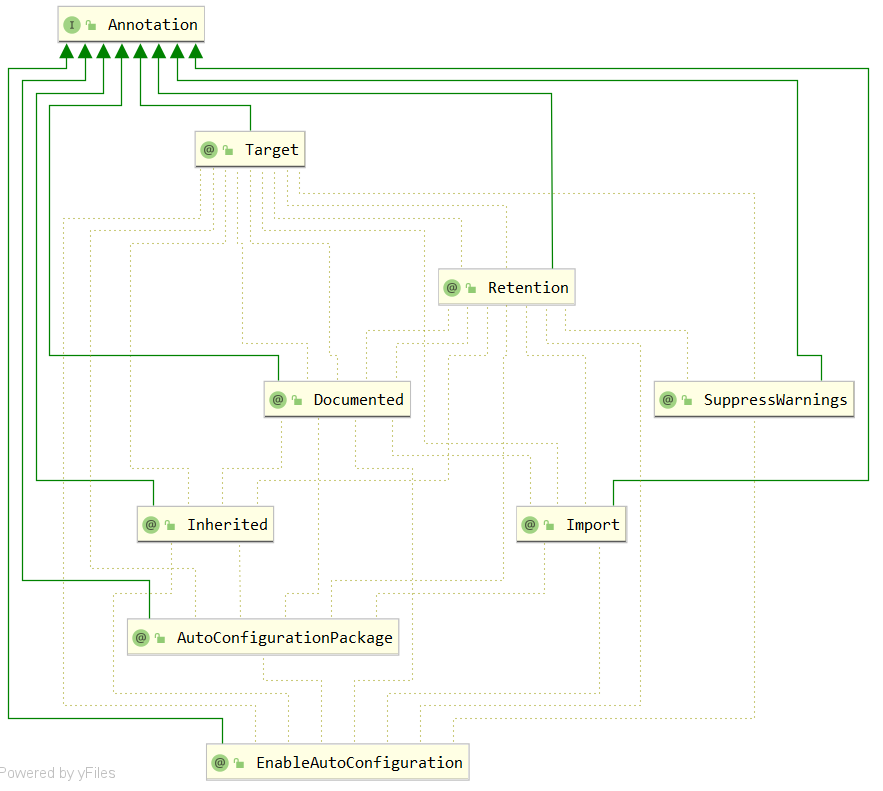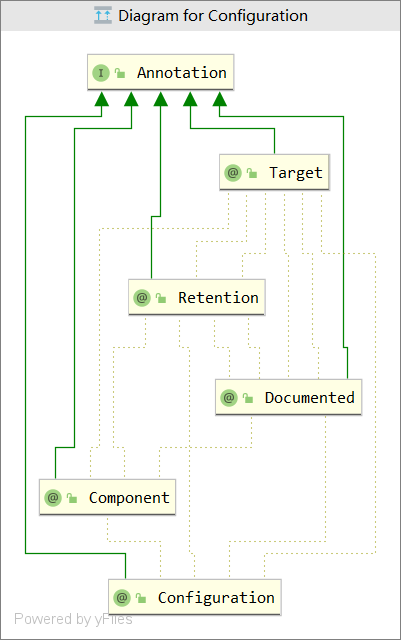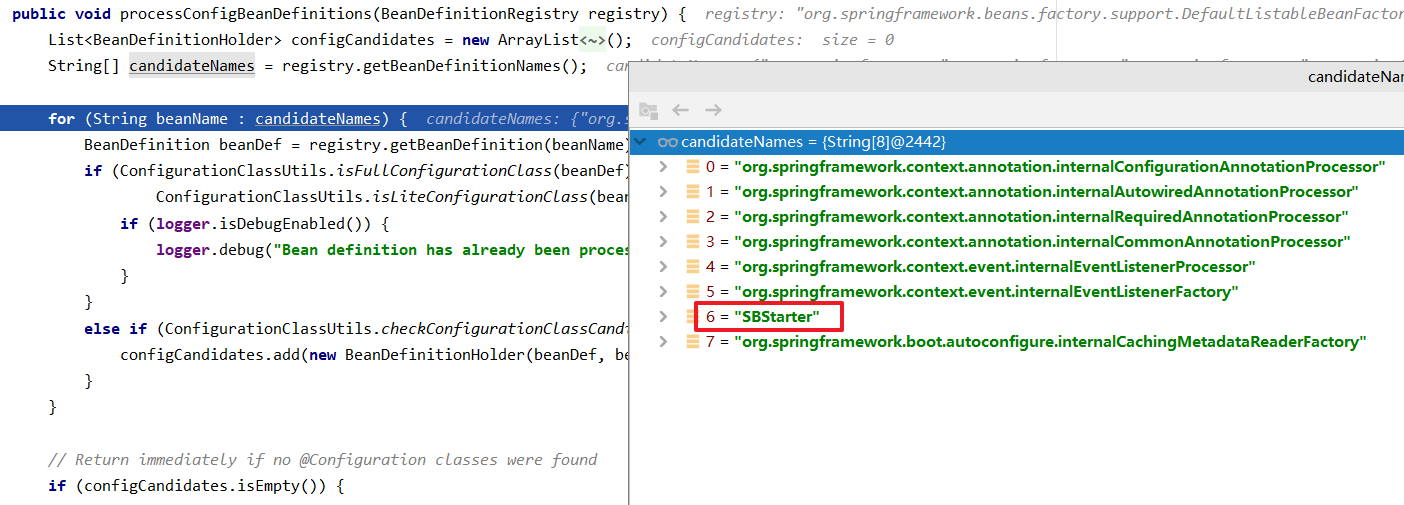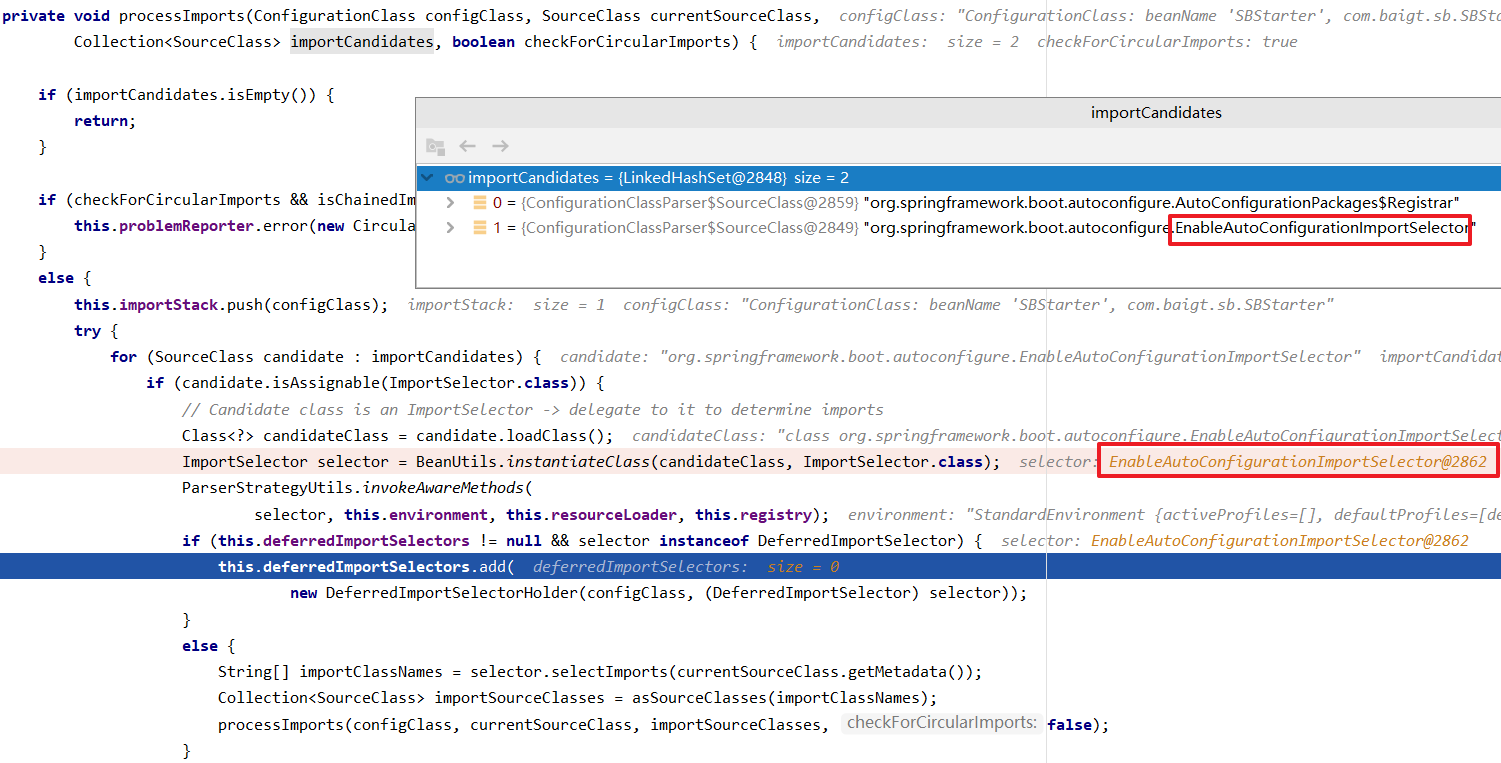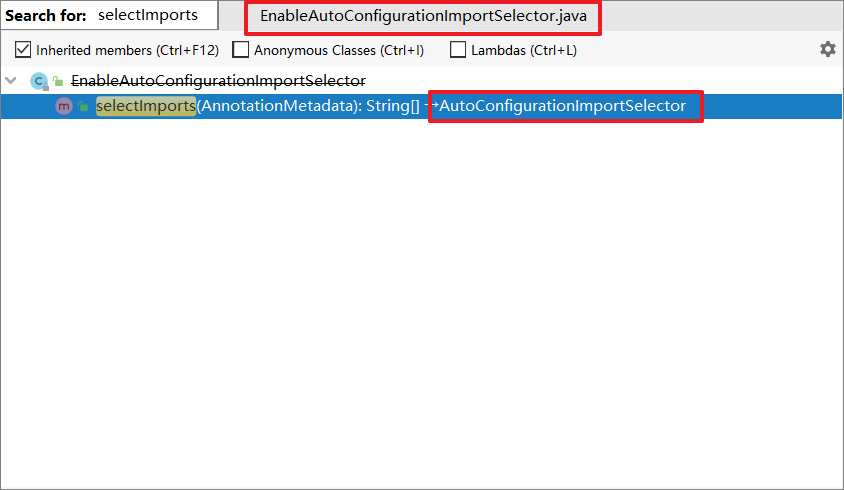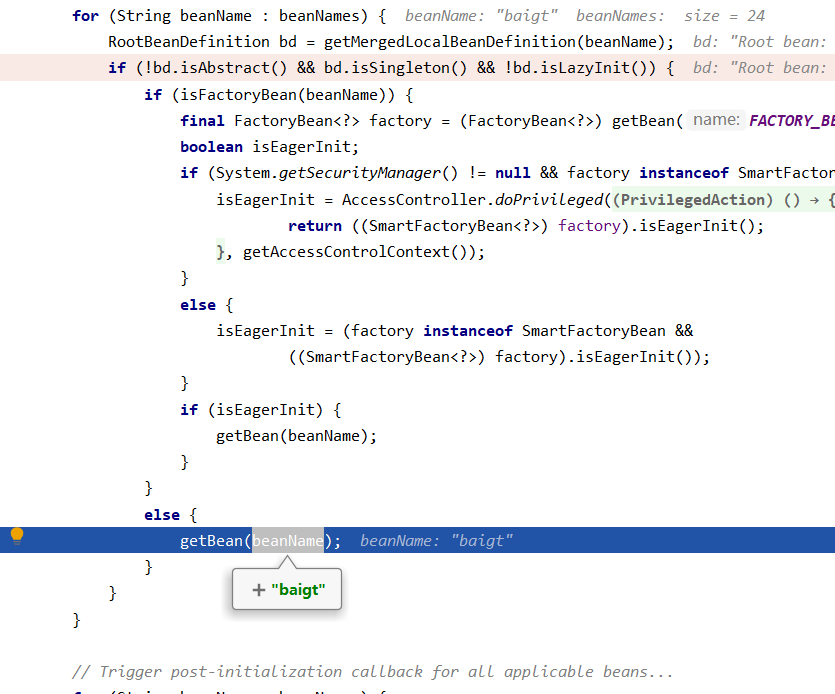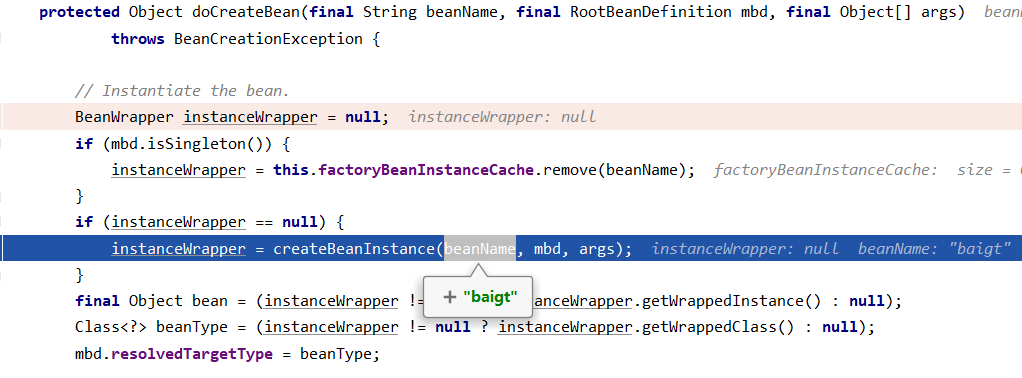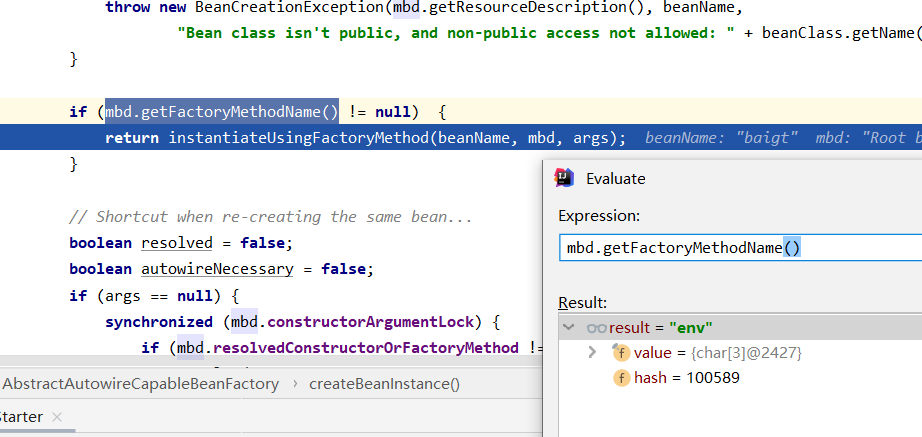源码分析@EnableAutoConfiguration在SpringBoot中的加载和实例化过程
万里长征第一步,我们先理解下什么是EnableAutoConfiguration?
什么是EnableAutoConfiguration注解?
在哪?
org.springframework.boot.autoconfigure.EnableAutoConfiguration
EnableAutoConfiguration概述
我们先来看下源码
package org.springframework.boot.autoconfigure;
import java.lang.annotation.Documented;
import java.lang.annotation.ElementType;
import java.lang.annotation.Inherited;
import java.lang.annotation.Retention;
import java.lang.annotation.RetentionPolicy;
import java.lang.annotation.Target;
import org.springframework.boot.autoconfigure.condition.ConditionalOnBean;
import org.springframework.boot.autoconfigure.condition.ConditionalOnClass;
import org.springframework.boot.autoconfigure.condition.ConditionalOnMissingBean;
import org.springframework.boot.context.embedded.EmbeddedServletContainerFactory;
import org.springframework.boot.context.embedded.tomcat.TomcatEmbeddedServletContainerFactory;
import org.springframework.context.annotation.Conditional;
import org.springframework.context.annotation.Configuration;
import org.springframework.context.annotation.Import;
import org.springframework.core.io.support.SpringFactoriesLoader;
/**
* Enable auto-configuration of the Spring Application Context, attempting to guess and
* configure beans that you are likely to need. Auto-configuration classes are usually
* applied based on your classpath and what beans you have defined. For example, If you
* have {@code tomcat-embedded.jar} on your classpath you are likely to want a
* {@link TomcatEmbeddedServletContainerFactory} (unless you have defined your own
* {@link EmbeddedServletContainerFactory} bean).
* <p>
* When using {@link SpringBootApplication}, the auto-configuration of the context is
* automatically enabled and adding this annotation has therefore no additional effect.
* <p>
* Auto-configuration tries to be as intelligent as possible and will back-away as you
* define more of your own configuration. You can always manually {@link #exclude()} any
* configuration that you never want to apply (use {@link #excludeName()} if you don't
* have access to them). You can also exclude them via the
* {@code spring.autoconfigure.exclude} property. Auto-configuration is always applied
* after user-defined beans have been registered.
* <p>
* The package of the class that is annotated with {@code @EnableAutoConfiguration},
* usually via {@code @SpringBootApplication}, has specific significance and is often used
* as a 'default'. For example, it will be used when scanning for {@code @Entity} classes.
* It is generally recommended that you place {@code @EnableAutoConfiguration} (if you're
* not using {@code @SpringBootApplication}) in a root package so that all sub-packages
* and classes can be searched.
* <p>
* Auto-configuration classes are regular Spring {@link Configuration} beans. They are
* located using the {@link SpringFactoriesLoader} mechanism (keyed against this class).
* Generally auto-configuration beans are {@link Conditional @Conditional} beans (most
* often using {@link ConditionalOnClass @ConditionalOnClass} and
* {@link ConditionalOnMissingBean @ConditionalOnMissingBean} annotations).
*/
@SuppressWarnings("deprecation")
@Target(ElementType.TYPE)
@Retention(RetentionPolicy.RUNTIME)
@Documented
@Inherited
@AutoConfigurationPackage
@Import(EnableAutoConfigurationImportSelector.class)
public @interface EnableAutoConfiguration {
String ENABLED_OVERRIDE_PROPERTY = "spring.boot.enableautoconfiguration";
/**
* Exclude specific auto-configuration classes such that they will never be applied.
* @return the classes to exclude
*/
Class<?>[] exclude() default {};
/**
* Exclude specific auto-configuration class names such that they will never be
* applied.
* @return the class names to exclude
* @since 1.3.0
*/
String[] excludeName() default {};
}
类图
![]()
注意“@Import(EnableAutoConfigurationImportSelector.class)” 部分。后边源码分析中会使用到。
说明
EnableAutoConfiguration注解的功能大概如下。
- 开启Spring应该上下文的自动配置,尽可能去加载需要的配置Beans。自动配置类,一般是根据你的classpath路径来应用的。
- 当你使用了SpringBootApplication注解,在context中自动加载配置就已经开启,不需要其他操作。
- 可以通过exclude()传入Class类型;excludeName() 传入名称来排除其他类型的加载。自动加载的配置始终是在普通用户定义的Bean加载之后执行。
- 默认EnableAutoConfiguration扫描的是当前启用注解的Class对象的目录作为root目录。所以这个目录下的所有子目录都会被扫描。
- 自动装载的配置类,也是常规的SpringBean(被@Configuration修饰,@Configuration则被@Component修饰(如果你写的@Configuration在启动类的包名下,开启注解扫描的情况下,也是会把@Configuration注册为Bean对象。))。当然也可以通过SpringFactoriesLoader的机制来定位到对应的org.springframework.boot.autoconfigure.EnableAutoConfiguration类(不在同用户扫描包目录中)。
- 一般配合Conditional、ConditionalOnClass、ConditionalOnMissingBean一起使用。
测试项目
│ pom.xml
└─src
└─main
├─java
│ └─com
│ └─baigt
│ ├─autoconfig
│ │ BaigtAutoConfig.java
│ │
│ └─sb
│ SBStarter.java
│
└─resources
└─META-INF
spring.factories
<?xml version="1.0" encoding="UTF-8"?>
<project xmlns="http://maven.apache.org/POM/4.0.0"
xmlns:xsi="http://www.w3.org/2001/XMLSchema-instance"
xsi:schemaLocation="http://maven.apache.org/POM/4.0.0 http://maven.apache.org/xsd/maven-4.0.0.xsd">
<modelVersion>4.0.0</modelVersion>
<groupId>org.baigt</groupId>
<artifactId>SpringBootCodeAnalyze</artifactId>
<version>1.0-SNAPSHOT</version>
<parent>
<groupId>org.springframework.boot</groupId>
<artifactId>spring-boot-starter-parent</artifactId>
<version>1.5.14.RELEASE</version>
</parent>
<dependencies>
<dependency>
<groupId>org.springframework.boot</groupId>
<artifactId>spring-boot-starter</artifactId>
</dependency>
</dependencies>
<build>
<plugins>
<plugin>
<groupId>org.springframework.boot</groupId>
<artifactId>spring-boot-maven-plugin</artifactId>
</plugin>
</plugins>
</build>
</project>
注意和启动类不在一个目录中
package com.baigt.autoconfig;
import org.springframework.context.annotation.Bean;
import org.springframework.context.annotation.Configuration;
/**
* 测试Autoconfig
*/
@Configuration
public class BaigtAutoConfig {
@Bean
public String env(){
return new String("Baigt Test");
}
}
注意和config不在一个目录 中
package com.baigt.sb;
import org.springframework.boot.SpringApplication;
import org.springframework.boot.autoconfigure.SpringBootApplication;
import org.springframework.context.ConfigurableApplicationContext;
/**
* 测试@EnableAutoConfig加载的流程(加载自定义的配置类,不在同一个目录中)
*/
@SpringBootApplication
public class SBStarter{
public static void main(String[] args) {
SpringApplication sb=new SpringApplication(SBStarter.class);
ConfigurableApplicationContext run = sb.run(args);
System.out.println(run.getBean("baigt",String.class));
}
}
# Auto Configure
org.springframework.boot.autoconfigure.EnableAutoConfiguration=\
com.baigt.autoconfig.BaigtAutoConfig
正题(源码)
我们只分析和EnableAutoConfiguration相关的源码。
new SpringApplication
初始化环境(是否是web),设置ApplicationContextInitializer、ApplicationListener,设置启动类的class到mainApplicationClass上。我们的例子中不是web环境。
//初始化入口
public SpringApplication(Object... sources) {
initialize(sources);
}
private void initialize(Object[] sources) {
if (sources != null && sources.length > 0) {
this.sources.addAll(Arrays.asList(sources));
}
this.webEnvironment = deduceWebEnvironment();
setInitializers((Collection) getSpringFactoriesInstances(
ApplicationContextInitializer.class));
setListeners((Collection) getSpringFactoriesInstances(ApplicationListener.class));
this.mainApplicationClass = deduceMainApplicationClass();
}
SpringApplication
启动SpringBoot项目,我们这里只关注Context创建和实例化AutoConfig相关的逻辑。注意我们的示例不是Web项目,只是个普通的java项目。
run
这里主要有三处,一个是createApplicationContext,一个是prepareContext,一个是refreshContext。
public ConfigurableApplicationContext run(String... args) {
//...
ConfigurableApplicationContext context = null;
//。。。
listeners.starting();
try {
//....
//注意这部分 创建context
context = createApplicationContext();
analyzers = new FailureAnalyzers(context);
prepareContext(context, environment, listeners, applicationArguments,
printedBanner);
//刷新context(实例化各种post以及Bean)
refreshContext(context);
afterRefresh(context, applicationArguments);
// ...
return context;
}
catch (Throwable ex) {
}
}
后边再讲refreshContext。
createApplicationContext
创建Context,我们不是web项目哦。所以我们Context是AnnotationConfigApplicationContext类型。
public static final String DEFAULT_CONTEXT_CLASS = "org.springframework.context."
+ "annotation.AnnotationConfigApplicationContext";
protected ConfigurableApplicationContext createApplicationContext() {
Class<?> contextClass = this.applicationContextClass;
if (contextClass == null) {
try {
//前边我们分析到,不是web 环境!! 所以我们Context是AnnotationConfigApplicationContext类型。
contextClass = Class.forName(this.webEnvironment
? DEFAULT_WEB_CONTEXT_CLASS : DEFAULT_CONTEXT_CLASS);
}
catch (ClassNotFoundException ex) {
//
}
}//这里实例化的是 AnnotationConfigApplicationContext类(无参构造)
return (ConfigurableApplicationContext) BeanUtils.instantiate(contextClass);
}
AnnotationConfigApplicationContext
类图
我们先看下类图。
![AnnotationConfigApplicationContext]()
- 是BeanDefinitionRegistry
- 是BeanFactory
- 是Resource
AnnotationConfigApplicationContext()
从前边我们了解到,我们的context是AnnotationConfigApplicationContext,无参构造会实例化AnnotatedBeanDefinitionReader和ClassPathBeanDefinitionScanner。因为Autoconfig相关的都会被@Configuration修饰,所以我们只关注AnnotatedBeanDefinitionReader,它是注解BeanDefinition读取器。我们主要分析说明的是这个。
public AnnotationConfigApplicationContext() {
this.reader = new AnnotatedBeanDefinitionReader(this);
this.scanner = new ClassPathBeanDefinitionScanner(this);
}
AnnotatedBeanDefinitionReader
AnnotatedBeanDefinitionReader(BeanDefinitionRegistry)
AnnotationConfigApplicationContext就是一个BeanDefinitionRegistry实例。将AnnotationConfigApplicationContext的实例传递到AnnotatedBeanDefinitionReader中使用。下边我们分析这个AnnotatedBeanDefinitionReader类实例化过程中都做了什么。
public AnnotatedBeanDefinitionReader(BeanDefinitionRegistry registry) {
this(registry, getOrCreateEnvironment(registry));
}
public AnnotatedBeanDefinitionReader(BeanDefinitionRegistry registry, Environment environment) {
Assert.notNull(registry, "BeanDefinitionRegistry must not be null");
Assert.notNull(environment, "Environment must not be null");
this.registry = registry;
this.conditionEvaluator = new ConditionEvaluator(registry, environment, null);
AnnotationConfigUtils.registerAnnotationConfigProcessors(this.registry);
}
AnnotationConfigUtils
registerAnnotationConfigProcessors
注册注解相关的后置处理器,比如ConfigurationClassPostProcessor、AutowiredAnnotationBeanPostProcessor、RequiredAnnotationBeanPostProcessor、CommonAnnotationBeanPostProcessor、PersistenceAnnotationBeanPostProcessor、EventListenerMethodProcessor、DefaultEventListenerFactory等。我们这里只关注配置类相关的源码部分。
public static void registerAnnotationConfigProcessors(BeanDefinitionRegistry registry) {
registerAnnotationConfigProcessors(registry, null);
}
public static Set<BeanDefinitionHolder> registerAnnotationConfigProcessors(
BeanDefinitionRegistry registry, Object source) {
DefaultListableBeanFactory beanFactory = unwrapDefaultListableBeanFactory(registry);
Set<BeanDefinitionHolder> beanDefs = new LinkedHashSet<BeanDefinitionHolder>(4);
// 注册ConfigurationClassPostProcessor处理器
if (!registry.containsBeanDefinition(CONFIGURATION_ANNOTATION_PROCESSOR_BEAN_NAME)) {
RootBeanDefinition def = new RootBeanDefinition(ConfigurationClassPostProcessor.class);
def.setSource(source);
beanDefs.add(registerPostProcessor(registry, def, CONFIGURATION_ANNOTATION_PROCESSOR_BEAN_NAME));
}
return beanDefs;
}
ConfigurationClassPostProcessor
类图
![]()
- 是BeanDefinitionRegistryPostProcessor
- 是BeanFactoryPostProcessor
- 是PriorityOrdered
- 上边两个接口,是关键,后边要用到!!!!
registerPostProcessor
注册ConfigurationClassPostProcessor处理器到BeanFactory中。
private static BeanDefinitionHolder registerPostProcessor(
BeanDefinitionRegistry registry, RootBeanDefinition definition, String beanName) {
definition.setRole(BeanDefinition.ROLE_INFRASTRUCTURE);
registry.registerBeanDefinition(beanName, definition);
return new BeanDefinitionHolder(definition, beanName);
}
BeanDefinitionRegistry
从入口处我们知道,registry是AnnotationConfigApplicationContext的实例,被传递过来。它的父类是GenericApplicationContext。在无参实例化时,GenericApplicationContext会持有一个DefaultListableBeanFactory对象。
-
结构图 ![]()
-
BeanFactory
GenericApplicationContext的实例化BeanFactory过程
private final DefaultListableBeanFactory beanFactory;
public GenericApplicationContext() {
this.beanFactory = new DefaultListableBeanFactory();
}
public void registerBeanDefinition(String beanName, BeanDefinition beanDefinition)
throws BeanDefinitionStoreException {
this.beanFactory.registerBeanDefinition(beanName, beanDefinition);
}
DefaultListableBeanFactory
registerBeanDefinition
将BeanDefinition定义交给BeanFactory管理。主要在beanDefinitionMap、beanDefinitionNames这几个map对象中存储。
public void registerBeanDefinition(String beanName, BeanDefinition beanDefinition)
throws BeanDefinitionStoreException {
Assert.hasText(beanName, "Bean name must not be empty");
Assert.notNull(beanDefinition, "BeanDefinition must not be null");
if (beanDefinition instanceof AbstractBeanDefinition) {
try {
((AbstractBeanDefinition) beanDefinition).validate();
}
catch (BeanDefinitionValidationException ex) {
throw new BeanDefinitionStoreException(beanDefinition.getResourceDescription(), beanName,
"Validation of bean definition failed", ex);
}
}
BeanDefinition oldBeanDefinition;
oldBeanDefinition = this.beanDefinitionMap.get(beanName);
if (oldBeanDefinition != null) {
if (!isAllowBeanDefinitionOverriding()) {
throw new BeanDefinitionStoreException(beanDefinition.getResourceDescription(), beanName,
"Cannot register bean definition [" + beanDefinition + "] for bean '" + beanName +
"': There is already [" + oldBeanDefinition + "] bound.");
}
else if (oldBeanDefinition.getRole() < beanDefinition.getRole()) {
// e.g. was ROLE_APPLICATION, now overriding with ROLE_SUPPORT or ROLE_INFRASTRUCTURE
if (this.logger.isWarnEnabled()) {
this.logger.warn("Overriding user-defined bean definition for bean '" + beanName +
"' with a framework-generated bean definition: replacing [" +
oldBeanDefinition + "] with [" + beanDefinition + "]");
}
}
else if (!beanDefinition.equals(oldBeanDefinition)) {
if (this.logger.isInfoEnabled()) {
this.logger.info("Overriding bean definition for bean '" + beanName +
"' with a different definition: replacing [" + oldBeanDefinition +
"] with [" + beanDefinition + "]");
}
}
else {
if (this.logger.isDebugEnabled()) {
this.logger.debug("Overriding bean definition for bean '" + beanName +
"' with an equivalent definition: replacing [" + oldBeanDefinition +
"] with [" + beanDefinition + "]");
}
}
this.beanDefinitionMap.put(beanName, beanDefinition);
}
else {
if (hasBeanCreationStarted()) {
// Cannot modify startup-time collection elements anymore (for stable iteration)
synchronized (this.beanDefinitionMap) {
this.beanDefinitionMap.put(beanName, beanDefinition);
List<String> updatedDefinitions = new ArrayList<String>(this.beanDefinitionNames.size() + 1);
updatedDefinitions.addAll(this.beanDefinitionNames);
updatedDefinitions.add(beanName);
this.beanDefinitionNames = updatedDefinitions;
if (this.manualSingletonNames.contains(beanName)) {
Set<String> updatedSingletons = new LinkedHashSet<String>(this.manualSingletonNames);
updatedSingletons.remove(beanName);
this.manualSingletonNames = updatedSingletons;
}
}
}
else {
// Still in startup registration phase
this.beanDefinitionMap.put(beanName, beanDefinition);
this.beanDefinitionNames.add(beanName);
this.manualSingletonNames.remove(beanName);
}
this.frozenBeanDefinitionNames = null;
}
if (oldBeanDefinition != null || containsSingleton(beanName)) {
resetBeanDefinition(beanName);
}
}
至此ConfigurationClassPostProcessor已经被BeanFactory管理起来。下边我们再来分析后边这个对象是怎么使用。那么我们再次回到SpringApplication的Run方法中prepareContext和**refreshContext(context);**部分。
SpringApplication
prepareContext
我们重点关注下load部分,传入的是当前启动类。source是new SpringApplication时传入的Class对象,也就是SBStarter.class。
private void prepareContext(ConfigurableApplicationContext context,
ConfigurableEnvironment environment, SpringApplicationRunListeners listeners,
ApplicationArguments applicationArguments, Banner printedBanner) {
//。。。。。
// Load the sources
Set<Object> sources = getSources();
Assert.notEmpty(sources, "Sources must not be empty");
load(context, sources.toArray(new Object[sources.size()]));
// 。。。。
}
load
加载bean到ApplicationContext中.BeanDefinitionLoader是持有Context对象的。Context本身就是个registry.
protected void load(ApplicationContext context, Object[] sources) {
if (logger.isDebugEnabled()) {
logger.debug(
"Loading source " + StringUtils.arrayToCommaDelimitedString(sources));
}
BeanDefinitionLoader loader = createBeanDefinitionLoader(
getBeanDefinitionRegistry(context), sources);
if (this.beanNameGenerator != null) {
loader.setBeanNameGenerator(this.beanNameGenerator);
}
if (this.resourceLoader != null) {
loader.setResourceLoader(this.resourceLoader);
}
if (this.environment != null) {
loader.setEnvironment(this.environment);
}
loader.load();
}
BeanDefinitionLoader
load
我们的source就是SBStarter.class,也就是会执行load((Class<?>) source)。最后注册成类型AnnotatedBeanDefinition的BeanDefinition。
public int load() {
int count = 0;
for (Object source : this.sources) {
count += load(source);
}
return count;
}
private int load(Object source) {
Assert.notNull(source, "Source must not be null");
if (source instanceof Class<?>) {
return load((Class<?>) source);
}
if (source instanceof Resource) {
return load((Resource) source);
}
if (source instanceof Package) {
return load((Package) source);
}
if (source instanceof CharSequence) {
return load((CharSequence) source);
}
throw new IllegalArgumentException("Invalid source type " + source.getClass());
}
private int load(Class<?> source) {
if (isGroovyPresent()) {
// Any GroovyLoaders added in beans{} DSL can contribute beans here
if (GroovyBeanDefinitionSource.class.isAssignableFrom(source)) {
GroovyBeanDefinitionSource loader = BeanUtils.instantiateClass(source,
GroovyBeanDefinitionSource.class);
load(loader);
}
}
//如果SBStarter是个组件的话,会注册到beanDefinition上去。
if (isComponent(source)) {
//AnnotatedBeanDefinitionReader是前边实例化时创建。目的是注册一个类型AnnotatedBeanDefinition的BeanDefinition
this.annotatedReader.register(source);
return 1;
}
return 0;
}
isComponent
- @SpringBootApplication是SpringBootConfiguration类型的。
![]()
- SpringBootConfiguration是Configuration类型的。
![]()
- Configuration是Component类型的
![]()
- 最后SBStarter也就是个Component类型的
AnnotatedBeanDefinitionReader
register
//annotatedClasses=com.baigt.sb.SBStarter
public void register(Class<?>... annotatedClasses) {
for (Class<?> annotatedClass : annotatedClasses) {
registerBean(annotatedClass);
}
}
registerBean
这里我们要注意的是我们是创建了一个AnnotatedGenericBeanDefinition类型的BeanDefinition对象通过BeanDefinitionReaderUtils工具进行注册的。
public void registerBean(Class<?> annotatedClass) {
registerBean(annotatedClass, null, (Class<? extends Annotation>[]) null);
}
public void registerBean(Class<?> annotatedClass, Class<? extends Annotation>... qualifiers) {
registerBean(annotatedClass, null, qualifiers);
}
public void registerBean(Class<?> annotatedClass, String name, Class<? extends Annotation>... qualifiers) {
//注意这里,我是一个AnnotatedGenericBeanDefinition类型的BeanDefinition实例
AnnotatedGenericBeanDefinition abd = new AnnotatedGenericBeanDefinition(annotatedClass);
if (this.conditionEvaluator.shouldSkip(abd.getMetadata())) {
return;
}
ScopeMetadata scopeMetadata = this.scopeMetadataResolver.resolveScopeMetadata(abd);
abd.setScope(scopeMetadata.getScopeName());
String beanName = (name != null ? name : this.beanNameGenerator.generateBeanName(abd, this.registry));
AnnotationConfigUtils.processCommonDefinitionAnnotations(abd);
if (qualifiers != null) {
for (Class<? extends Annotation> qualifier : qualifiers) {
if (Primary.class == qualifier) {
abd.setPrimary(true);
}
else if (Lazy.class == qualifier) {
abd.setLazyInit(true);
}
else {
abd.addQualifier(new AutowireCandidateQualifier(qualifier));
}
}
}
BeanDefinitionHolder definitionHolder = new BeanDefinitionHolder(abd, beanName);
definitionHolder = AnnotationConfigUtils.applyScopedProxyMode(scopeMetadata, definitionHolder, this.registry);
//我是在这里和context关联上的
BeanDefinitionReaderUtils.registerBeanDefinition(definitionHolder, this.registry);
}
BeanDefinitionReaderUtils
registerBeanDefinition
注意传入的registry,AnnotationConfigApplicationContext本身就是个BeanDefinitionRegistry。而这个部分最后调用的是AnnotationConfigApplicationContext在实例化中隐式实例化父类GenericApplicationContext时创建的一个DefaultListableBeanFactory对象的registerBeanDefinition方法。这就又回到了ConfiguationClassPostProcessor时registerBeanDefinition的过程。因此这里就不再继续深入分析。最终的结果是交给了BeanFactory统一管理BeanDefinition!!
public static void registerBeanDefinition(
BeanDefinitionHolder definitionHolder, BeanDefinitionRegistry registry)
throws BeanDefinitionStoreException {
// Register bean definition under primary name.
String beanName = definitionHolder.getBeanName();
registry.registerBeanDefinition(beanName, definitionHolder.getBeanDefinition());
// Register aliases for bean name, if any.
String[] aliases = definitionHolder.getAliases();
if (aliases != null) {
for (String alias : aliases) {
registry.registerAlias(beanName, alias);
}
}
}
SpringApplication
refreshContext
刷新Context和注册关机钩子;注意传入的是一个AnnotationConfigApplicationContext实例。我们主要分析refresh
private void refreshContext(ConfigurableApplicationContext context) {
refresh(context);
if (this.registerShutdownHook) {
try {
context.registerShutdownHook();
}
catch (AccessControlException ex) {
// Not allowed in some environments.
}
}
}
protected void refresh(ApplicationContext applicationContext) {
Assert.isInstanceOf(AbstractApplicationContext.class, applicationContext);
((AbstractApplicationContext) applicationContext).refresh();
}
刷新用的是AbstractApplicationContext中的refresh方法。
AbstractApplicationContext
org.springframework.context.support.AbstractApplicationContext
refresh
在ConfigurationClassPostProcessor那一部分,我们知道它是一个BeanFactoryPostProcessor。所以我们一定要看的是invokeBeanFactoryPostProcessors部分的逻辑,其次因为Configuration注解类中相关的如@Bean修饰的方法也是要实例化的,所以我们还要看的是finishBeanFactoryInitialization中的逻辑。
public void refresh() throws BeansException, IllegalStateException {
synchronized (this.startupShutdownMonitor) {
// refresh的前置准备,比如设置startTime,开启激活状态、关闭close状态等等等
prepareRefresh();
//告诉子类去刷新内容Bean工厂(从类图中可以明显看出来入口类实例也是个bean工厂)
// 观察和刷新BeanFactory
ConfigurableListableBeanFactory beanFactory = obtainFreshBeanFactory();
//提前设置一些在该context中使用的属性,比如Classloader、Callback、environment等
prepareBeanFactory(beanFactory);
try {
// 通知context子类,后置处理beanFactory。比如用一系列的Webcontext子类
postProcessBeanFactory(beanFactory);
// 将BeanFactoryPostProcessor在当前Context中注册为Bean
invokeBeanFactoryPostProcessors(beanFactory);
// 注册BeanPostProcessor来拦截Bean创建的后置处理。
registerBeanPostProcessors(beanFactory);
// 为当前Context初始化MessageSource
initMessageSource();
// 为当前context初始化应用事件广播
initApplicationEventMulticaster();
// 初始化其他特殊的bean对象 比如webcontext
onRefresh();
// 检查监听Bean 并发布他们(ApplicationListener)
registerListeners();
// 实例化BeanFactory中所有的其他的单例对象集合(非延迟的)
finishBeanFactoryInitialization(beanFactory);
// 最后发布LifecycleProcessor和ContextRefreshedEvent事件
finishRefresh();
}
catch (BeansException ex) {
if (logger.isWarnEnabled()) {
logger.warn("Exception encountered during context initialization - " +
"cancelling refresh attempt: " + ex);
}
// 失败销毁bean
destroyBeans();
// Reset 'active' flag.
cancelRefresh(ex);
// Propagate exception to caller.
throw ex;
}
finally {
// Reset common introspection caches in Spring's core, since we
// might not ever need metadata for singleton beans anymore...
resetCommonCaches();
}
}
}
invokeBeanFactoryPostProcessors
使用委托模式来执行BeanFactoryPostProcessors。注意委托类PostProcessorRegistrationDelegate接收的beanFactory是我们的Context实例(是个BeanFactory,同时它也持有ConfigurationClassPostProcessor的BeanDefinition信息)。getBeanFactoryPostProcessors部分中的BeanFactoryPostProcessors是其他步骤中注入的后置器,我们这里不关注。直接进委托类中继续 分析。
protected void invokeBeanFactoryPostProcessors(ConfigurableListableBeanFactory beanFactory) {
PostProcessorRegistrationDelegate.invokeBeanFactoryPostProcessors(beanFactory, getBeanFactoryPostProcessors());
// Detect a LoadTimeWeaver and prepare for weaving, if found in the meantime
// (e.g. through an @Bean method registered by ConfigurationClassPostProcessor)
if (beanFactory.getTempClassLoader() == null && beanFactory.containsBean(LOAD_TIME_WEAVER_BEAN_NAME)) {
beanFactory.addBeanPostProcessor(new LoadTimeWeaverAwareProcessor(beanFactory));
beanFactory.setTempClassLoader(new ContextTypeMatchClassLoader(beanFactory.getBeanClassLoader()));
}
}
PostProcessorRegistrationDelegate
org.springframework.context.support.PostProcessorRegistrationDelegate
invokeBeanFactoryPostProcessors
我们不关注beanFactoryPostProcessors部分传入的参数,因为ConfigurationClassPostProcessor不在此。前边我们分析到ConfigurationClassPostProcessor同时是一个BeanDefinitionRegistryPostProcessor,invokeBeanFactoryPostProcessors中与此有关的逻辑我们重点看下!!!
- 首先执行实现PriorityOrdered接口的BeanDefinitionRegistryPostProcessor
- 其次执行实现Ordered接口的BeanDefinitionRegistryPostProcessor
- 最后执行其他所有的BeanDefinitionRegistryPostProcessor对象
public static void invokeBeanFactoryPostProcessors(
ConfigurableListableBeanFactory beanFactory, List<BeanFactoryPostProcessor> beanFactoryPostProcessors) {
// Invoke BeanDefinitionRegistryPostProcessors first, if any.
Set<String> processedBeans = new HashSet<String>();
if (beanFactory instanceof BeanDefinitionRegistry) {
BeanDefinitionRegistry registry = (BeanDefinitionRegistry) beanFactory;
List<BeanFactoryPostProcessor> regularPostProcessors = new LinkedList<BeanFactoryPostProcessor>();
List<BeanDefinitionRegistryPostProcessor> registryProcessors = new LinkedList<BeanDefinitionRegistryPostProcessor>();
for (BeanFactoryPostProcessor postProcessor : beanFactoryPostProcessors) {
//省略
}
List<BeanDefinitionRegistryPostProcessor> currentRegistryProcessors = new ArrayList<BeanDefinitionRegistryPostProcessor>();
// 首先执行一个实现PriorityOrdered接口的BeanDefinitionRegistryPostProcessors!!! 这不就是我们的ConfigurationClassPostProcessor嘛!!!
String[] postProcessorNames =
beanFactory.getBeanNamesForType(BeanDefinitionRegistryPostProcessor.class, true, false);
for (String ppName : postProcessorNames) {
if (beanFactory.isTypeMatch(ppName, PriorityOrdered.class)) {
currentRegistryProcessors.add(beanFactory.getBean(ppName, BeanDefinitionRegistryPostProcessor.class));
processedBeans.add(ppName);
}
}
sortPostProcessors(currentRegistryProcessors, beanFactory);
registryProcessors.addAll(currentRegistryProcessors);
invokeBeanDefinitionRegistryPostProcessors(currentRegistryProcessors, registry);
currentRegistryProcessors.clear();
// 其次执行一个实现Ordered接口的BeanDefinitionRegistryPostProcessors!!! 且没有在processedBeans中
postProcessorNames = beanFactory.getBeanNamesForType(BeanDefinitionRegistryPostProcessor.class, true, false);
for (String ppName : postProcessorNames) {
if (!processedBeans.contains(ppName) && beanFactory.isTypeMatch(ppName, Ordered.class)) {
currentRegistryProcessors.add(beanFactory.getBean(ppName, BeanDefinitionRegistryPostProcessor.class));
processedBeans.add(ppName);
}
}
sortPostProcessors(currentRegistryProcessors, beanFactory);
registryProcessors.addAll(currentRegistryProcessors);
invokeBeanDefinitionRegistryPostProcessors(currentRegistryProcessors, registry);
currentRegistryProcessors.clear();
// 最后执行其他 BeanDefinitionRegistryPostProcessor
boolean reiterate = true;
while (reiterate) {
reiterate = false;
postProcessorNames = beanFactory.getBeanNamesForType(BeanDefinitionRegistryPostProcessor.class, true, false);
for (String ppName : postProcessorNames) {
if (!processedBeans.contains(ppName)) {
currentRegistryProcessors.add(beanFactory.getBean(ppName, BeanDefinitionRegistryPostProcessor.class));
processedBeans.add(ppName);
reiterate = true;
}
}
sortPostProcessors(currentRegistryProcessors, beanFactory);
registryProcessors.addAll(currentRegistryProcessors);
invokeBeanDefinitionRegistryPostProcessors(currentRegistryProcessors, registry);
currentRegistryProcessors.clear();
}
// Now, invoke the postProcessBeanFactory callback of all processors handled so far.
invokeBeanFactoryPostProcessors(registryProcessors, beanFactory);
invokeBeanFactoryPostProcessors(regularPostProcessors, beanFactory);
}
else {
// Invoke factory processors registered with the context instance.
invokeBeanFactoryPostProcessors(beanFactoryPostProcessors, beanFactory);
}
// Do not initialize FactoryBeans here: We need to leave all regular beans
// uninitialized to let the bean factory post-processors apply to them!
String[] postProcessorNames =
beanFactory.getBeanNamesForType(BeanFactoryPostProcessor.class, true, false);
// Separate between BeanFactoryPostProcessors that implement PriorityOrdered,
// Ordered, and the rest.
List<BeanFactoryPostProcessor> priorityOrderedPostProcessors = new ArrayList<BeanFactoryPostProcessor>();
List<String> orderedPostProcessorNames = new ArrayList<String>();
List<String> nonOrderedPostProcessorNames = new ArrayList<String>();
for (String ppName : postProcessorNames) {
if (processedBeans.contains(ppName)) {
// skip - already processed in first phase above
}
else if (beanFactory.isTypeMatch(ppName, PriorityOrdered.class)) {
priorityOrderedPostProcessors.add(beanFactory.getBean(ppName, BeanFactoryPostProcessor.class));
}
else if (beanFactory.isTypeMatch(ppName, Ordered.class)) {
orderedPostProcessorNames.add(ppName);
}
else {
nonOrderedPostProcessorNames.add(ppName);
}
}
// First, invoke the BeanFactoryPostProcessors that implement PriorityOrdered.
sortPostProcessors(priorityOrderedPostProcessors, beanFactory);
invokeBeanFactoryPostProcessors(priorityOrderedPostProcessors, beanFactory);
// Next, invoke the BeanFactoryPostProcessors that implement Ordered.
List<BeanFactoryPostProcessor> orderedPostProcessors = new ArrayList<BeanFactoryPostProcessor>();
for (String postProcessorName : orderedPostProcessorNames) {
orderedPostProcessors.add(beanFactory.getBean(postProcessorName, BeanFactoryPostProcessor.class));
}
sortPostProcessors(orderedPostProcessors, beanFactory);
invokeBeanFactoryPostProcessors(orderedPostProcessors, beanFactory);
// Finally, invoke all other BeanFactoryPostProcessors.
List<BeanFactoryPostProcessor> nonOrderedPostProcessors = new ArrayList<BeanFactoryPostProcessor>();
for (String postProcessorName : nonOrderedPostProcessorNames) {
nonOrderedPostProcessors.add(beanFactory.getBean(postProcessorName, BeanFactoryPostProcessor.class));
}
invokeBeanFactoryPostProcessors(nonOrderedPostProcessors, beanFactory);
// Clear cached merged bean definitions since the post-processors might have
// modified the original metadata, e.g. replacing placeholders in values...
beanFactory.clearMetadataCache();
}
- 我们只关注第一个,因为ConfigurationClassPostProcessor实现了PriorityOrdered接口!!!!
invokeBeanDefinitionRegistryPostProcessors
传入的postProcessors是ConfigurationClassPostProcessor,传入的registry则是我们的AnnotationConfigApplicationContext(前边也提到了他也是个BeanDefinitionRegistry)。哇偶!终于到了我们ConfigurationClassPostProcessor的源码部分了(postProcessBeanDefinitionRegistry)
private static void invokeBeanDefinitionRegistryPostProcessors(
Collection<? extends BeanDefinitionRegistryPostProcessor> postProcessors, BeanDefinitionRegistry registry) {
for (BeanDefinitionRegistryPostProcessor postProcessor : postProcessors) {
postProcessor.postProcessBeanDefinitionRegistry(registry);
}
}
ConfigurationClassPostProcessor
postProcessBeanDefinitionRegistry
这个方法比较简单,有些检查,核心方法是processConfigBeanDefinitions。我们跟进去看下。
public void postProcessBeanDefinitionRegistry(BeanDefinitionRegistry registry) {
int registryId = System.identityHashCode(registry);
if (this.registriesPostProcessed.contains(registryId)) {
throw new IllegalStateException(
"postProcessBeanDefinitionRegistry already called on this post-processor against " + registry);
}
if (this.factoriesPostProcessed.contains(registryId)) {
throw new IllegalStateException(
"postProcessBeanFactory already called on this post-processor against " + registry);
}
this.registriesPostProcessed.add(registryId);
processConfigBeanDefinitions(registry);
}
processConfigBeanDefinitions
类的Doc说明是构建和验证由Configuration注解修饰的Class对象。注意注入的BeanDefinitionRegistry是一个DefaultListableBeanFactory实例,因此也是一个SingletonBeanRegistry对象。具体可自行分析类图的继承关系。这里会加载我们启动类SBStarter这个配置类。
启动类SBStarter是我们自定义的类,是在org.springframework.boot.SpringApplication#prepareContext步骤中注入的。
![]()
/**
* Build and validate a configuration model based on the registry of
* {@link Configuration} classes.
*/
public void processConfigBeanDefinitions(BeanDefinitionRegistry registry) {
List<BeanDefinitionHolder> configCandidates = new ArrayList<BeanDefinitionHolder>();
String[] candidateNames = registry.getBeanDefinitionNames();
for (String beanName : candidateNames) {
BeanDefinition beanDef = registry.getBeanDefinition(beanName);
//是否已经加载过
if (ConfigurationClassUtils.isFullConfigurationClass(beanDef) ||
ConfigurationClassUtils.isLiteConfigurationClass(beanDef)) {
}
//没有加载过 就放入configCandidates集合中 这里只有我们手写的启动类SBStarter是没有被加载过的。具体加载过程上边我们已经说过了 我们这里看下SBStarter的后续操作。
else if (ConfigurationClassUtils.checkConfigurationClassCandidate(beanDef, this.metadataReaderFactory)) {
configCandidates.add(new BeanDefinitionHolder(beanDef, beanName));
}
}
// 没有就快速返回
if (configCandidates.isEmpty()) {
return;
}
// 根据Order排序
Collections.sort(configCandidates, new Comparator<BeanDefinitionHolder>() {
@Override
public int compare(BeanDefinitionHolder bd1, BeanDefinitionHolder bd2) {
int i1 = ConfigurationClassUtils.getOrder(bd1.getBeanDefinition());
int i2 = ConfigurationClassUtils.getOrder(bd2.getBeanDefinition());
return (i1 < i2) ? -1 : (i1 > i2) ? 1 : 0;
}
});
// Detect any custom bean name generation strategy supplied through the enclosing application context
SingletonBeanRegistry sbr = null;
if (registry instanceof SingletonBeanRegistry) {
sbr = (SingletonBeanRegistry) registry;
if (!this.localBeanNameGeneratorSet && sbr.containsSingleton(CONFIGURATION_BEAN_NAME_GENERATOR)) {
BeanNameGenerator generator = (BeanNameGenerator) sbr.getSingleton(CONFIGURATION_BEAN_NAME_GENERATOR);
this.componentScanBeanNameGenerator = generator;
this.importBeanNameGenerator = generator;
}
}
// 解析每一个 @Configuration class 这里只解析到我们开启SpringBootApplication注解的SBStarter类是Configuration class,我们写的那个不在扫描路径中。
ConfigurationClassParser parser = new ConfigurationClassParser(
this.metadataReaderFactory, this.problemReporter, this.environment,
this.resourceLoader, this.componentScanBeanNameGenerator, registry);
Set<BeanDefinitionHolder> candidates = new LinkedHashSet<BeanDefinitionHolder>(configCandidates);
Set<ConfigurationClass> alreadyParsed = new HashSet<ConfigurationClass>(configCandidates.size());
do {
//从SBStarter为入口解析Configuration相关Class
parser.parse(candidates);
parser.validate();
Set<ConfigurationClass> configClasses = new LinkedHashSet<ConfigurationClass>(parser.getConfigurationClasses());
configClasses.removeAll(alreadyParsed);
// Read the model and create bean definitions based on its content
if (this.reader == null) {
this.reader = new ConfigurationClassBeanDefinitionReader(
registry, this.sourceExtractor, this.resourceLoader, this.environment,
this.importBeanNameGenerator, parser.getImportRegistry());
}
// 在这里加载成BeanDefinition 并交给BeanFactory管理。
this.reader.loadBeanDefinitions(configClasses);
alreadyParsed.addAll(configClasses);
candidates.clear();
if (registry.getBeanDefinitionCount() > candidateNames.length) {
String[] newCandidateNames = registry.getBeanDefinitionNames();
Set<String> oldCandidateNames = new HashSet<String>(Arrays.asList(candidateNames));
Set<String> alreadyParsedClasses = new HashSet<String>();
for (ConfigurationClass configurationClass : alreadyParsed) {
alreadyParsedClasses.add(configurationClass.getMetadata().getClassName());
}
for (String candidateName : newCandidateNames) {
if (!oldCandidateNames.contains(candidateName)) {
BeanDefinition bd = registry.getBeanDefinition(candidateName);
if (ConfigurationClassUtils.checkConfigurationClassCandidate(bd, this.metadataReaderFactory) &&
!alreadyParsedClasses.contains(bd.getBeanClassName())) {
candidates.add(new BeanDefinitionHolder(bd, candidateName));
}
}
}
candidateNames = newCandidateNames;
}
}
while (!candidates.isEmpty());
// Register the ImportRegistry as a bean in order to support ImportAware @Configuration classes
if (sbr != null) {
if (!sbr.containsSingleton(IMPORT_REGISTRY_BEAN_NAME)) {
sbr.registerSingleton(IMPORT_REGISTRY_BEAN_NAME, parser.getImportRegistry());
}
}
if (this.metadataReaderFactory instanceof CachingMetadataReaderFactory) {
((CachingMetadataReaderFactory) this.metadataReaderFactory).clearCache();
}
}
ConfigurationClassParser
parse(set)
这里主要分析两个部分,一个是再次Parse(不同入参),一个是完整流程(processDeferredImportSelectors())
- SBStarter注入的BeanDefiniton是个AnnotatedBeanDefinition
触发parse(AnnotationMetadata metadata, String beanName)调用
public void parse(Set<BeanDefinitionHolder> configCandidates) {
this.deferredImportSelectors = new LinkedList<DeferredImportSelectorHolder>();
for (BeanDefinitionHolder holder : configCandidates) {
BeanDefinition bd = holder.getBeanDefinition();
try {
if (bd instanceof AnnotatedBeanDefinition) {
parse(((AnnotatedBeanDefinition) bd).getMetadata(), holder.getBeanName());
}
else if (bd instanceof AbstractBeanDefinition && ((AbstractBeanDefinition) bd).hasBeanClass()) {
parse(((AbstractBeanDefinition) bd).getBeanClass(), holder.getBeanName());
}
else {
parse(bd.getBeanClassName(), holder.getBeanName());
}
}
catch (BeanDefinitionStoreException ex) {
throw ex;
}
catch (Throwable ex) {
throw new BeanDefinitionStoreException(
"Failed to parse configuration class [" + bd.getBeanClassName() + "]", ex);
}
}
processDeferredImportSelectors();
}
parse(AnnotationMetadata, String)
protected final void parse(AnnotationMetadata metadata, String beanName) throws IOException {
processConfigurationClass(new ConfigurationClass(metadata, beanName));
}
processConfigurationClass
处理ConfigurationClass对象。主要是doProcessConfigurationClass部分。
protected void processConfigurationClass(ConfigurationClass configClass) throws IOException {
if (this.conditionEvaluator.shouldSkip(configClass.getMetadata(), ConfigurationPhase.PARSE_CONFIGURATION)) {
return;
}
ConfigurationClass existingClass = this.configurationClasses.get(configClass);
if (existingClass != null) {
if (configClass.isImported()) {
if (existingClass.isImported()) {
existingClass.mergeImportedBy(configClass);
}
// Otherwise ignore new imported config class; existing non-imported class overrides it.
return;
}
else {
// Explicit bean definition found, probably replacing an import.
// Let's remove the old one and go with the new one.
this.configurationClasses.remove(configClass);
for (Iterator<ConfigurationClass> it = this.knownSuperclasses.values().iterator(); it.hasNext();) {
if (configClass.equals(it.next())) {
it.remove();
}
}
}
}
// Recursively process the configuration class and its superclass hierarchy.
SourceClass sourceClass = asSourceClass(configClass);
do {
sourceClass = doProcessConfigurationClass(configClass, sourceClass);
}
while (sourceClass != null);
this.configurationClasses.put(configClass, configClass);
}
doProcessConfigurationClass
这里很重要了,也是很复杂的一部分。不过也是SpringBoot可以不使用Xml就能扫描注解相关类的关键部分。下边大概涉及到@PropertySources,@PropertySource,@ComponentScans.class, @ComponentScan.class,@Import,@ImportSource等等。我们主要关注的是@Import部分。为什么?因为我们还是目的就是想看@EnableAutoConfiguration是怎么加载不同目录下的配置类,并实例化的!!! 而在@EnableAutoConfiguration中有使用了@Import,@Import(EnableAutoConfigurationImportSelector.class)
protected final SourceClass doProcessConfigurationClass(ConfigurationClass configClass, SourceClass sourceClass)
throws IOException {
// 处理成员class 比如内部class 静态class
processMemberClasses(configClass, sourceClass);
// 处理 @PropertySource annotations
for (AnnotationAttributes propertySource : AnnotationConfigUtils.attributesForRepeatable(
sourceClass.getMetadata(), PropertySources.class,
org.springframework.context.annotation.PropertySource.class)) {
if (this.environment instanceof ConfigurableEnvironment) {
processPropertySource(propertySource);
}
else {
logger.warn("Ignoring @PropertySource annotation on [" + sourceClass.getMetadata().getClassName() +
"]. Reason: Environment must implement ConfigurableEnvironment");
}
}
// 处理 @ComponentScan annotations
Set<AnnotationAttributes> componentScans = AnnotationConfigUtils.attributesForRepeatable(
sourceClass.getMetadata(), ComponentScans.class, ComponentScan.class);
if (!componentScans.isEmpty() &&
!this.conditionEvaluator.shouldSkip(sourceClass.getMetadata(), ConfigurationPhase.REGISTER_BEAN)) {
for (AnnotationAttributes componentScan : componentScans) {
// The config class is annotated with @ComponentScan -> perform the scan immediately
Set<BeanDefinitionHolder> scannedBeanDefinitions =
this.componentScanParser.parse(componentScan, sourceClass.getMetadata().getClassName());
// Check the set of scanned definitions for any further config classes and parse recursively if needed
for (BeanDefinitionHolder holder : scannedBeanDefinitions) {
BeanDefinition bdCand = holder.getBeanDefinition().getOriginatingBeanDefinition();
if (bdCand == null) {
bdCand = holder.getBeanDefinition();
}
if (ConfigurationClassUtils.checkConfigurationClassCandidate(bdCand, this.metadataReaderFactory)) {
parse(bdCand.getBeanClassName(), holder.getBeanName());
}
}
}
}
// 处理 any @Import annotations 我们Spring.factories就是在这一部分 会解析出org.springframework.boot.autoconfigure.EnableAutoConfigurationImportSelector
processImports(configClass, sourceClass, getImports(sourceClass), true);
// 处理 any @ImportResource annotations 如果手动引入了xml配置文件 基本是这种的
if (sourceClass.getMetadata().isAnnotated(ImportResource.class.getName())) {
AnnotationAttributes importResource =
AnnotationConfigUtils.attributesFor(sourceClass.getMetadata(), ImportResource.class);
String[] resources = importResource.getStringArray("locations");
Class<? extends BeanDefinitionReader> readerClass = importResource.getClass("reader");
for (String resource : resources) {
String resolvedResource = this.environment.resolveRequiredPlaceholders(resource);
configClass.addImportedResource(resolvedResource, readerClass);
}
}
// Process individual @Bean methods
Set<MethodMetadata> beanMethods = retrieveBeanMethodMetadata(sourceClass);
for (MethodMetadata methodMetadata : beanMethods) {
configClass.addBeanMethod(new BeanMethod(methodMetadata, configClass));
}
// Process default methods on interfaces
processInterfaces(configClass, sourceClass);
// Process superclass, if any
if (sourceClass.getMetadata().hasSuperClass()) {
String superclass = sourceClass.getMetadata().getSuperClassName();
if (!superclass.startsWith("java") && !this.knownSuperclasses.containsKey(superclass)) {
this.knownSuperclasses.put(superclass, configClass);
// Superclass found, return its annotation metadata and recurse
return sourceClass.getSuperClass();
}
}
// No superclass -> processing is complete
return null;
}
processImports
从EnableAutoConfigurationImportSelector中获取Spring.factories中key=org.springframework.boot.autoconfigure.EnableAutoConfiguration的需要自动化加载的配置类。最后存放在deferredImportSelectors集合中。
![]()
private void processImports(ConfigurationClass configClass, SourceClass currentSourceClass,
Collection<SourceClass> importCandidates, boolean checkForCircularImports) {
if (importCandidates.isEmpty()) {
return;
}
if (checkForCircularImports && isChainedImportOnStack(configClass)) {
this.problemReporter.error(new CircularImportProblem(configClass, this.importStack));
}
else {
this.importStack.push(configClass);
try {
for (SourceClass candidate : importCandidates) {
if (candidate.isAssignable(ImportSelector.class)) {
// Candidate class is an ImportSelector -> delegate to it to determine imports
Class<?> candidateClass = candidate.loadClass();
//实例化EnableAutoConfigurationImportSelector 存放在deferredImportSelectors中
ImportSelector selector = BeanUtils.instantiateClass(candidateClass, ImportSelector.class);
ParserStrategyUtils.invokeAwareMethods(
selector, this.environment, this.resourceLoader, this.registry);
if (this.deferredImportSelectors != null && selector instanceof DeferredImportSelector) {
this.deferredImportSelectors.add(
new DeferredImportSelectorHolder(configClass, (DeferredImportSelector) selector));
}
else {
String[] importClassNames = selector.selectImports(currentSourceClass.getMetadata());
Collection<SourceClass> importSourceClasses = asSourceClasses(importClassNames);
processImports(configClass, currentSourceClass, importSourceClasses, false);
}
}
else {
//省略代码
}
}
}
catch (BeanDefinitionStoreException ex) {
//
}
finally {
this.importStack.pop();
}
}
}
parse(Set<BeanDefinitionHolder> configCandidates)
返回到此处,执行 processDeferredImportSelectors方法。处理刚才存放在deferredImportSelectors中的import对象。
public void parse(Set<BeanDefinitionHolder> configCandidates) {
this.deferredImportSelectors = new LinkedList<DeferredImportSelectorHolder>();
for (BeanDefinitionHolder holder : configCandidates) {
BeanDefinition bd = holder.getBeanDefinition();
try {
if (bd instanceof AnnotatedBeanDefinition) {
parse(((AnnotatedBeanDefinition) bd).getMetadata(), holder.getBeanName());
}
else if (bd instanceof AbstractBeanDefinition && ((AbstractBeanDefinition) bd).hasBeanClass()) {
parse(((AbstractBeanDefinition) bd).getBeanClass(), holder.getBeanName());
}
else {
parse(bd.getBeanClassName(), holder.getBeanName());
}
}
catch (BeanDefinitionStoreException ex) {
throw ex;
}
}
//处理我们刚才存放在这里的deferredImportSelectors
processDeferredImportSelectors();
}
processDeferredImportSelectors
调用ImportSelector类的selectImports方法,最后递归调用processImports来处理其他Configuration类。这里我们来看下EnableAutoConfigurationImportSelector的selectImports方法。
private void processDeferredImportSelectors() {
List<DeferredImportSelectorHolder> deferredImports = this.deferredImportSelectors;
this.deferredImportSelectors = null;
Collections.sort(deferredImports, DEFERRED_IMPORT_COMPARATOR);
for (DeferredImportSelectorHolder deferredImport : deferredImports) {
ConfigurationClass configClass = deferredImport.getConfigurationClass();
try {
String[] imports = deferredImport.getImportSelector().selectImports(configClass.getMetadata());
processImports(configClass, asSourceClass(configClass), asSourceClasses(imports), false);
}
catch (BeanDefinitionStoreException ex) {
}
}
}
EnableAutoConfigurationImportSelector
@EnableAutoConfiguration 中@Import引入的ImportSelector。我们Ctrl+F12来看下selectImports方法在哪?
![]()
AutoConfigurationImportSelector
EnableAutoConfigurationImportSelector 的父类。selectImports方法所在的类。我们重点关注getCandidateConfigurations方法的源码。通过SpringFactoriesLoader.loadFactoryNames来加载spring.factories中对应key为EnableAutoConfiguration的ConfigClass集合。
public String[] selectImports(AnnotationMetadata annotationMetadata) {
//如果不是EnableAutoConfigurationImportSelector的时候 isEnabled==true 默认AutoConfigurationImportSelector的isEnable==true ,走后边的逻辑
if (!isEnabled(annotationMetadata)) {
return NO_IMPORTS;
}
try {
AutoConfigurationMetadata autoConfigurationMetadata = AutoConfigurationMetadataLoader
.loadMetadata(this.beanClassLoader);
AnnotationAttributes attributes = getAttributes(annotationMetadata);
//获取需要自动化加载配置类 这个是核心类。我们下边分析
List<String> configurations = getCandidateConfigurations(annotationMetadata,
attributes);
//删除重复的configClass
configurations = removeDuplicates(configurations);
//排序
configurations = sort(configurations, autoConfigurationMetadata);
Set<String> exclusions = getExclusions(annotationMetadata, attributes);
//删除exclue掉的Class
checkExcludedClasses(configurations, exclusions);
configurations.removeAll(exclusions);
//处理AutoConfigurationImportFilter
configurations = filter(configurations, autoConfigurationMetadata);
//处理AutoConfigurationImportListener
fireAutoConfigurationImportEvents(configurations, exclusions);
return configurations.toArray(new String[configurations.size()]);
}
catch (IOException ex) {
throw new IllegalStateException(ex);
}
}
// 通过SpringFactoriesLoader加载EnableAutoConfiguration相关的配置类
protected List<String> getCandidateConfigurations(AnnotationMetadata metadata,
AnnotationAttributes attributes) {
List<String> configurations = SpringFactoriesLoader.loadFactoryNames(
getSpringFactoriesLoaderFactoryClass(), getBeanClassLoader());
Assert.notEmpty(configurations,
"No auto configuration classes found in META-INF/spring.factories. If you "
+ "are using a custom packaging, make sure that file is correct.");
return configurations;
}
// 要通过SpringFactories来加载的类
protected Class<?> getSpringFactoriesLoaderFactoryClass() {
return EnableAutoConfiguration.class;
}
SpringFactoriesLoader
loadFactoryNames
//从META-INF/spring.factories的文件中解析内容(所有的spring.factories。包括spring-boot-1.5.14.RELEASE.jar中的)。从中拿到org.springframework.boot.autoconfigure.EnableAutoConfiguration对应的配置类,比如我们自己定义的BaigtAutoConfig类。
![]()
public static final String FACTORIES_RESOURCE_LOCATION = "META-INF/spring.factories";
public static List<String> loadFactoryNames(Class<?> factoryClass, ClassLoader classLoader) {
//factoryClassName=org.springframework.boot.autoconfigure.EnableAutoConfiguration
String factoryClassName = factoryClass.getName();
try {
//从META-INF/spring.factories的文件中解析内容(所有的spring.factories。包括spring-boot-1.5.14.RELEASE.jar中的)
Enumeration<URL> urls = (classLoader != null ? classLoader.getResources(FACTORIES_RESOURCE_LOCATION) :
ClassLoader.getSystemResources(FACTORIES_RESOURCE_LOCATION));
List<String> result = new ArrayList<String>();
while (urls.hasMoreElements()) {
URL url = urls.nextElement();
//转换为Properties
Properties properties = PropertiesLoaderUtils.loadProperties(new UrlResource(url));
//从properties中获取EnableAutoConfiguration对应的Value 比如我们的com.baigt.autoconfig.BaigtAutoConfig
String factoryClassNames = properties.getProperty(factoryClassName);
result.addAll(Arrays.asList(StringUtils.commaDelimitedListToStringArray(factoryClassNames)));
}
return result;
}
catch (IOException ex) {
}
}
接下来我们返回到ConfigurationClassPostProcessor的processConfigBeanDefinitions方法。
ConfigurationClassPostProcessor
processConfigBeanDefinitions
接下来我们来看下**this.reader.loadBeanDefinitions(configClasses);**加载我们配置类,交给beanFactory管理。
![]()
public void processConfigBeanDefinitions(BeanDefinitionRegistry registry) {
List<BeanDefinitionHolder> configCandidates = new ArrayList<BeanDefinitionHolder>();
String[] candidateNames = registry.getBeanDefinitionNames();
//。。。。
// Parse each @Configuration class
ConfigurationClassParser parser = new ConfigurationClassParser(
this.metadataReaderFactory, this.problemReporter, this.environment,
this.resourceLoader, this.componentScanBeanNameGenerator, registry);
Set<BeanDefinitionHolder> candidates = new LinkedHashSet<BeanDefinitionHolder>(configCandidates);
Set<ConfigurationClass> alreadyParsed = new HashSet<ConfigurationClass>(configCandidates.size());
do {
parser.parse(candidates);
parser.validate();
Set<ConfigurationClass> configClasses = new LinkedHashSet<ConfigurationClass>(parser.getConfigurationClasses());
configClasses.removeAll(alreadyParsed);
// Read the model and create bean definitions based on its content
if (this.reader == null) {
this.reader = new ConfigurationClassBeanDefinitionReader(
registry, this.sourceExtractor, this.resourceLoader, this.environment,
this.importBeanNameGenerator, parser.getImportRegistry());
}
this.reader.loadBeanDefinitions(configClasses);
alreadyParsed.addAll(configClasses);
}
ConfigurationClassBeanDefinitionReader
loadBeanDefinitions
我们只关注我们定义的配置类(BaigtAutoConfig)
public void loadBeanDefinitions(Set<ConfigurationClass> configurationModel) {
TrackedConditionEvaluator trackedConditionEvaluator = new TrackedConditionEvaluator();
for (ConfigurationClass configClass : configurationModel) {
loadBeanDefinitionsForConfigurationClass(configClass, trackedConditionEvaluator);
}
}
loadBeanDefinitionsForConfigurationClass
处理配置类中上的注解(比如Import),以及@Bean方法
![]()
private void loadBeanDefinitionsForConfigurationClass(
ConfigurationClass configClass, TrackedConditionEvaluator trackedConditionEvaluator) {
if (trackedConditionEvaluator.shouldSkip(configClass)) {
String beanName = configClass.getBeanName();
if (StringUtils.hasLength(beanName) && this.registry.containsBeanDefinition(beanName)) {
this.registry.removeBeanDefinition(beanName);
}
this.importRegistry.removeImportingClass(configClass.getMetadata().getClassName());
return;
}
// BaigtAutoConfig是通过Import(SelectImports)来创建的ConfigClass 所以这里是true
if (configClass.isImported()) {
//将该配置类注册为BeanDefinition
registerBeanDefinitionForImportedConfigurationClass(configClass);
}
// BaigtAutoConfig中有个@Bean修饰的方法 也会执行这个方法
for (BeanMethod beanMethod : configClass.getBeanMethods()) {
loadBeanDefinitionsForBeanMethod(beanMethod);
}
//配置类中如果使用了ImportSource注解和ImportBeanDefinitionRegistrar。则去加载相关内容成BeanDefinition
loadBeanDefinitionsFromImportedResources(configClass.getImportedResources());
loadBeanDefinitionsFromRegistrars(configClass.getImportBeanDefinitionRegistrars());
}
registerBeanDefinitionForImportedConfigurationClass
将BaigtAutoConfig配置类注册为BeanDefinition
![]()
private void registerBeanDefinitionForImportedConfigurationClass(ConfigurationClass configClass) {
AnnotationMetadata metadata = configClass.getMetadata();
AnnotatedGenericBeanDefinition configBeanDef = new AnnotatedGenericBeanDefinition(metadata);
ScopeMetadata scopeMetadata = scopeMetadataResolver.resolveScopeMetadata(configBeanDef);
configBeanDef.setScope(scopeMetadata.getScopeName());
String configBeanName = this.importBeanNameGenerator.generateBeanName(configBeanDef, this.registry);
AnnotationConfigUtils.processCommonDefinitionAnnotations(configBeanDef, metadata);
BeanDefinitionHolder definitionHolder = new BeanDefinitionHolder(configBeanDef, configBeanName);
definitionHolder = AnnotationConfigUtils.applyScopedProxyMode(scopeMetadata, definitionHolder, this.registry);
// 注册我们的BaigtAutoConfig
this.registry.registerBeanDefinition(definitionHolder.getBeanName(), definitionHolder.getBeanDefinition());
configClass.setBeanName(configBeanName);
}
loadBeanDefinitionsForBeanMethod
![]()
解析@Bean方法中相关的属性,比如设置factoryMethod、InitMethod、DestroyMethod、beanName、alias等。也设置lazy、dependOn等等。最后this.registry.registerBeanDefinition(beanName, beanDefToRegister); 完成配置类中@Bean方法的注册。this.registry又是我们前边提到的DefaultListableBeanFactory。交给BeanFactory管理。
private void loadBeanDefinitionsForBeanMethod(BeanMethod beanMethod) {
ConfigurationClass configClass = beanMethod.getConfigurationClass();
MethodMetadata metadata = beanMethod.getMetadata();
String methodName = metadata.getMethodName();
// 这一步(shouldSkip)会设置mergedBeanDefinitions中该name的scope为单例。即使没有这个在最后判断的时候scope=""时也等价于单例
if (this.conditionEvaluator.shouldSkip(metadata, ConfigurationPhase.REGISTER_BEAN)) {
configClass.skippedBeanMethods.add(methodName);
return;
}
if (configClass.skippedBeanMethods.contains(methodName)) {
return;
}
// Consider name and any aliases
AnnotationAttributes bean = AnnotationConfigUtils.attributesFor(metadata, Bean.class);
List<String> names = new ArrayList<String>(Arrays.asList(bean.getStringArray("name")));
String beanName = (!names.isEmpty() ? names.remove(0) : methodName);
// Register aliases even when overridden
for (String alias : names) {
this.registry.registerAlias(beanName, alias);
}
// Has this effectively been overridden before (e.g. via XML)?
if (isOverriddenByExistingDefinition(beanMethod, beanName)) {
if (beanName.equals(beanMethod.getConfigurationClass().getBeanName())) {
throw new BeanDefinitionStoreException(beanMethod.getConfigurationClass().getResource().getDescription(),
beanName, "Bean name derived from @Bean method '" + beanMethod.getMetadata().getMethodName() +
"' clashes with bean name for containing configuration class; please make those names unique!");
}
return;
}
ConfigurationClassBeanDefinition beanDef = new ConfigurationClassBeanDefinition(configClass, metadata);
beanDef.setResource(configClass.getResource());
beanDef.setSource(this.sourceExtractor.extractSource(metadata, configClass.getResource()));
if (metadata.isStatic()) {
// static @Bean method
beanDef.setBeanClassName(configClass.getMetadata().getClassName());
beanDef.setFactoryMethodName(methodName);
}
else {
// instance @Bean method
beanDef.setFactoryBeanName(configClass.getBeanName());
beanDef.setUniqueFactoryMethodName(methodName);
}
beanDef.setAutowireMode(RootBeanDefinition.AUTOWIRE_CONSTRUCTOR);
beanDef.setAttribute(RequiredAnnotationBeanPostProcessor.SKIP_REQUIRED_CHECK_ATTRIBUTE, Boolean.TRUE);
AnnotationConfigUtils.processCommonDefinitionAnnotations(beanDef, metadata);
Autowire autowire = bean.getEnum("autowire");
if (autowire.isAutowire()) {
beanDef.setAutowireMode(autowire.value());
}
String initMethodName = bean.getString("initMethod");
if (StringUtils.hasText(initMethodName)) {
beanDef.setInitMethodName(initMethodName);
}
String destroyMethodName = bean.getString("destroyMethod");
if (destroyMethodName != null) {
beanDef.setDestroyMethodName(destroyMethodName);
}
// Consider scoping
ScopedProxyMode proxyMode = ScopedProxyMode.NO;
AnnotationAttributes attributes = AnnotationConfigUtils.attributesFor(metadata, Scope.class);
if (attributes != null) {
beanDef.setScope(attributes.getString("value"));
proxyMode = attributes.getEnum("proxyMode");
if (proxyMode == ScopedProxyMode.DEFAULT) {
proxyMode = ScopedProxyMode.NO;
}
}
// Replace the original bean definition with the target one, if necessary
BeanDefinition beanDefToRegister = beanDef;
if (proxyMode != ScopedProxyMode.NO) {
BeanDefinitionHolder proxyDef = ScopedProxyCreator.createScopedProxy(
new BeanDefinitionHolder(beanDef, beanName), this.registry,
proxyMode == ScopedProxyMode.TARGET_CLASS);
beanDefToRegister = new ConfigurationClassBeanDefinition(
(RootBeanDefinition) proxyDef.getBeanDefinition(), configClass, metadata);
}
if (logger.isDebugEnabled()) {
logger.debug(String.format("Registering bean definition for @Bean method %s.%s()",
configClass.getMetadata().getClassName(), beanName));
}
this.registry.registerBeanDefinition(beanName, beanDefToRegister);
}
接下来,我们回到 AbstractApplicationContext#refresh
AbstractApplicationContext
refresh
finishBeanFactoryInitialization(beanFactory);
finishBeanFactoryInitialization
通过beanFactory来实例化我们之前交给它管理的BeanDefinition。
protected void finishBeanFactoryInitialization(ConfigurableListableBeanFactory beanFactory) {
//省略一些代码
// 实例化一些单例(non-lazyinit)
beanFactory.preInstantiateSingletons();
}
DefaultListableBeanFactory
preInstantiateSingletons
实例化beanDefinitionNames中定义BeanDefinition的单例。当然也包含我们的BaigtAutoConfig中对应的@Bean(name="baigt")方法的BeanDefinition
![]()
![]()
public void preInstantiateSingletons() throws BeansException {
// 从我们放入到beanDefinitionNames中来遍历进行实例化。
List<String> beanNames = new ArrayList<String>(this.beanDefinitionNames);
// Trigger initialization of all non-lazy singleton beans...
for (String beanName : beanNames) {
RootBeanDefinition bd = getMergedLocalBeanDefinition(beanName);
if (!bd.isAbstract() && bd.isSingleton() && !bd.isLazyInit()) {
if (isFactoryBean(beanName)) {
final FactoryBean<?> factory = (FactoryBean<?>) getBean(FACTORY_BEAN_PREFIX + beanName);
boolean isEagerInit;
if (System.getSecurityManager() != null && factory instanceof SmartFactoryBean) {
isEagerInit = AccessController.doPrivileged(new PrivilegedAction<Boolean>() {
@Override
public Boolean run() {
return ((SmartFactoryBean<?>) factory).isEagerInit();
}
}, getAccessControlContext());
}
else {
isEagerInit = (factory instanceof SmartFactoryBean &&
((SmartFactoryBean<?>) factory).isEagerInit());
}
if (isEagerInit) {
getBean(beanName);
}
}
else {
// 最后执行这个方法进行实例化
getBean(beanName);
}
}
}
// SmartInitializingSingleton的处理
}
AbstractBeanFactory
getBean
public Object getBean(String name) throws BeansException {
return doGetBean(name, null, null, false);
}
doGetBean
这里我们就是要创建单例的实例(有就从缓存中取)。创建的方式是通过ObjectFactory内部类实现中的createBean方法来完成。我们先看下getSingleton的逻辑。
![]()
// 首次进来为空 最后会走下边的逻辑
Object sharedInstance = getSingleton(beanName);
// 通过this.beanDefinitionMap得到的 具体可自行查看源码。这里不太花篇幅讲述。
final RootBeanDefinition mbd = getMergedLocalBeanDefinition(beanName);
//...
if (mbd.isSingleton()) {
sharedInstance = getSingleton(beanName, new ObjectFactory<Object>() {
@Override
public Object getObject() throws BeansException {
try {
//最终创建Bean的逻辑
return createBean(beanName, mbd, args);
}
catch (BeansException ex) {
destroySingleton(beanName);
throw ex;
}
}
});
bean = getObjectForBeanInstance(sharedInstance, name, beanName, mbd);
}
//....
// 注意这里,会把单例cache起来,在后边可以直接使用
if (newSingleton) {
addSingleton(beanName, singletonObject);
}
DefaultSingletonBeanRegistry
getSingleton
这里我们要分析的核心逻辑(instance singleton)是调用的了ObjectFactory.getObject,即我们上边的内部类,而内部类的实现则是通过createBean完成。我们再来看下createBean的逻辑。
try {
//回到了AbstractBeanFactory#doGetBean的ObjectFactory的getObject方法,执行其中的createBean方法
singletonObject = singletonFactory.getObject();
newSingleton = true;
}
AbstractAutowireCapableBeanFactory
createBean
AbstractBeanFactory的子类实现方法
AbstractAutowireCapableBeanFactory#createBean(java.lang.Class<T>)
public <T> T createBean(Class<T> beanClass) throws BeansException {
// Use prototype bean definition, to avoid registering bean as dependent bean.
RootBeanDefinition bd = new RootBeanDefinition(beanClass);
bd.setScope(SCOPE_PROTOTYPE);
bd.allowCaching = ClassUtils.isCacheSafe(beanClass, getBeanClassLoader());
return (T) createBean(beanClass.getName(), bd, null);
}
// 接上
protected Object createBean(String beanName, RootBeanDefinition mbd, Object[] args) throws BeanCreationException {
RootBeanDefinition mbdToUse = mbd;
Class<?> resolvedClass = resolveBeanClass(mbd, beanName);
if (resolvedClass != null && !mbd.hasBeanClass() && mbd.getBeanClassName() != null) {
mbdToUse = new RootBeanDefinition(mbd);
mbdToUse.setBeanClass(resolvedClass);
}
try {
mbdToUse.prepareMethodOverrides();
}
catch (BeanDefinitionValidationException ex) {
}
try {
// Give BeanPostProcessors a chance to return a proxy instead of the target bean instance.
Object bean = resolveBeforeInstantiation(beanName, mbdToUse);
if (bean != null) {
return bean;
}
}
catch (Throwable ex) {
}
// 普通Bean的实例创建
Object beanInstance = doCreateBean(beanName, mbdToUse, args);
if (logger.isDebugEnabled()) {
logger.debug("Finished creating instance of bean '" + beanName + "'");
}
return beanInstance;
}
doCreateBean
核心关注instanceWrapper和exposedObject对象的处理过程
![]()
BeanWrapper instanceWrapper = null;
if (mbd.isSingleton()) {
instanceWrapper = this.factoryBeanInstanceCache.remove(beanName);
}
if (instanceWrapper == null) {
//创建bean实例的Wrapper对象
instanceWrapper = createBeanInstance(beanName, mbd, args);
}
// bean实例在wrapper中已经创建了(不完整)
final Object bean = (instanceWrapper != null ? instanceWrapper.getWrappedInstance() : null);
//省略一些代码。。。
// Initialize the bean instance.
Object exposedObject = bean;
try {
// 注入property到Bean中
populateBean(beanName, mbd, instanceWrapper);
if (exposedObject != null) {
exposedObject = initializeBean(beanName, exposedObject, mbd);
}
}
//省略一些代码。。。
return exposedObject;
createBeanInstance
instanceWrapper = createBeanInstance(beanName, mbd, args); 该方法是给指定的name的Class创建Bean对象,支持无参、factoryMethod、AutoWireConstructor三种策略。默认执行无参的"instantiateBean"。而我们的BaigtAutoConfig中的@Bean则设置的有FactoryMethodName(我们定义的@Bean的方法名="env")
![]()
protected BeanWrapper createBeanInstance(String beanName, RootBeanDefinition mbd, Object[] args) {
// Make sure bean class is actually resolved at this point.
Class<?> beanClass = resolveBeanClass(mbd, beanName);
if (beanClass != null && !Modifier.isPublic(beanClass.getModifiers()) && !mbd.isNonPublicAccessAllowed()) {
throw new BeanCreationException(mbd.getResourceDescription(), beanName,
"Bean class isn't public, and non-public access not allowed: " + beanClass.getName());
}
//配置类中的@Bean方法是通过下边这种方式实例化的。
if (mbd.getFactoryMethodName() != null) {
return instantiateUsingFactoryMethod(beanName, mbd, args);
}
// Shortcut when re-creating the same bean...
boolean resolved = false;
boolean autowireNecessary = false;
if (args == null) {
synchronized (mbd.constructorArgumentLock) {
if (mbd.resolvedConstructorOrFactoryMethod != null) {
resolved = true;
autowireNecessary = mbd.constructorArgumentsResolved;
}
}
}
// 一般我们不是FactoryMethod和有参构造(也可以有哈)
if (resolved) {
if (autowireNecessary) {
return autowireConstructor(beanName, mbd, null, null);
}
else {
return instantiateBean(beanName, mbd);
}
}
// Need to determine the constructor...
Constructor<?>[] ctors = determineConstructorsFromBeanPostProcessors(beanClass, beanName);
if (ctors != null ||
mbd.getResolvedAutowireMode() == RootBeanDefinition.AUTOWIRE_CONSTRUCTOR ||
mbd.hasConstructorArgumentValues() || !ObjectUtils.isEmpty(args)) {
return autowireConstructor(beanName, mbd, ctors, args);
}
//没有特殊处理就使用无参构造实例
// No special handling: simply use no-arg constructor.
return instantiateBean(beanName, mbd);
}
instantiateUsingFactoryMethod
protected BeanWrapper instantiateUsingFactoryMethod(
String beanName, RootBeanDefinition mbd, Object[] explicitArgs) {
return new ConstructorResolver(this).instantiateUsingFactoryMethod(beanName, mbd, explicitArgs);
}
ConstructorResolver
instantiateUsingFactoryMethod
![]()
BeanWrapperImpl bw = new BeanWrapperImpl();
this.beanFactory.initBeanWrapper(bw);
//。。。。
Object beanInstance;
beanInstance = this.beanFactory.getInstantiationStrategy().instantiate(
mbd, beanName, this.beanFactory, factoryBean, factoryMethodToUse, argsToUse);
bw.setBeanInstance(beanInstance);
return bw;
SimpleInstantiationStrategy
instantiate
最后调用@Bean对应的方法的invoke方法。到此配置类中的@Bean已经实例化完成。
![]()
public Object instantiate(RootBeanDefinition bd, String beanName, BeanFactory owner,
Object factoryBean, final Method factoryMethod, Object... args) {
try {
if (System.getSecurityManager() != null) {
AccessController.doPrivileged(new PrivilegedAction<Object>() {
@Override
public Object run() {
ReflectionUtils.makeAccessible(factoryMethod);
return null;
}
});
}
else {
ReflectionUtils.makeAccessible(factoryMethod);
}
Method priorInvokedFactoryMethod = currentlyInvokedFactoryMethod.get();
try {
currentlyInvokedFactoryMethod.set(factoryMethod);
//执行方法
return factoryMethod.invoke(factoryBean, args);
}
finally {
if (priorInvokedFactoryMethod != null) {
currentlyInvokedFactoryMethod.set(priorInvokedFactoryMethod);
}
else {
currentlyInvokedFactoryMethod.remove();
}
}
}
catch (IllegalArgumentException ex) {
throws ex;
}
}
AbstractAutowireCapableBeanFactory
返回到doCreateBean方法
doCreateBean
我们继续看exposedObject处理的内容。装载Bean的Property属性,initBean对象。我们着重看下initializeBean方法。
final Object bean = (instanceWrapper != null ? instanceWrapper.getWrappedInstance() : null);
Object exposedObject = bean;
try {
//装载比如Property属性 可以是其他Bean对象,也可能是String等基本属性。 具体见populateBean中的applyPropertyValues方法
populateBean(beanName, mbd, instanceWrapper);
if (exposedObject != null) {
//初始化Bean对象
exposedObject = initializeBean(beanName, exposedObject, mbd);
}
}
initializeBean
- org.springframework.beans.factory.support.AbstractAutowireCapableBeanFactory#initializeBean(java.lang.String, java.lang.Object, org.springframework.beans.factory.support.RootBeanDefinition)
初始化给定的Bean,(RootBeanDefinition为空时,执行BeanPost)执行wired的相关方法((BeanNameAware、BeanClassLoaderAware、BeanFactoryAware))、执行initMethod。比如InitializingBean#afterPropertiesSet();或者是自定义的init方法。
protected Object initializeBean(final String beanName, final Object bean, RootBeanDefinition mbd) {
if (System.getSecurityManager() != null) {
AccessController.doPrivileged(new PrivilegedAction<Object>() {
@Override
public Object run() {
invokeAwareMethods(beanName, bean);
return null;
}
}, getAccessControlContext());
}
else {
//执行wire的method(BeanNameAware、BeanClassLoaderAware、BeanFactoryAware)
invokeAwareMethods(beanName, bean);
}
Object wrappedBean = bean;
if (mbd == null || !mbd.isSynthetic()) {
wrappedBean = applyBeanPostProcessorsBeforeInitialization(wrappedBean, beanName);
}
try {
//执行init方法
invokeInitMethods(beanName, wrappedBean, mbd);
}
catch (Throwable ex) {
throw new BeanCreationException(
(mbd != null ? mbd.getResourceDescription() : null),
beanName, "Invocation of init method failed", ex);
}
if (mbd == null || !mbd.isSynthetic()) {
wrappedBean = applyBeanPostProcessorsAfterInitialization(wrappedBean, beanName);
}
return wrappedBean;
}
invokeInitMethods
org.springframework.beans.factory.support.AbstractAutowireCapableBeanFactory#invokeInitMethods。执行afterPropertiesSet方法。如果是自定义的init方法,就调用invokeCustomInitMethod。
protected void invokeInitMethods(String beanName, final Object bean, RootBeanDefinition mbd)
throws Throwable {
boolean isInitializingBean = (bean instanceof InitializingBean);
if (isInitializingBean && (mbd == null || !mbd.isExternallyManagedInitMethod("afterPropertiesSet"))) {
if (logger.isDebugEnabled()) {
logger.debug("Invoking afterPropertiesSet() on bean with name '" + beanName + "'");
}
if (System.getSecurityManager() != null) {
try {
AccessController.doPrivileged(new PrivilegedExceptionAction<Object>() {
@Override
public Object run() throws Exception {
((InitializingBean) bean).afterPropertiesSet();
return null;
}
}, getAccessControlContext());
}
catch (PrivilegedActionException pae) {
throw pae.getException();
}
}
else {
((InitializingBean) bean).afterPropertiesSet();
}
}
if (mbd != null) {
String initMethodName = mbd.getInitMethodName();
if (initMethodName != null && !(isInitializingBean && "afterPropertiesSet".equals(initMethodName)) &&
!mbd.isExternallyManagedInitMethod(initMethodName)) {
invokeCustomInitMethod(beanName, bean, mbd);
}
}
}
AbstractApplicationContext
返回到refresh方法
refresh
至此配置类相关的Bean实例化完成。
// Instantiate all remaining (non-lazy-init) singletons.
finishBeanFactoryInitialization(beanFactory);
其他Bean
我们这里只关注的是配置类的加载,普通Bean的加载可以看我的另外一篇文章 彻底弄懂Spring中Bean的解析、创建和使用
结语
分析使用的Spring版本为4.3.18。代码上如有出入,请自行区分。最后如有不对,欢迎指正。 作者:ricky QQ交流群:244930845。
